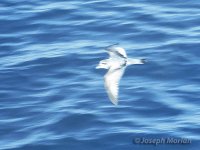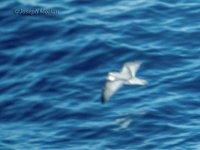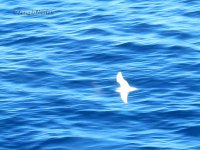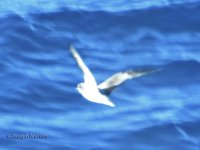Yes, there seems to be rampant confusion. When I suggest that the bird might be Salvin's, I am following Clements taxonomy which considers MacGillivray's to be a race. However, Clements and IOC have the ranges wrong. Macgillivray's Prion's only known breeding site is Gough where its population size is estimated at between 100,000 and 1 million mature individuals.
Some details at:
https://globally-threatened-bird-fo...st-concern-and-p-macgillivrayi-as-endangered/
See also:
https://www.hbw.com/species/macgillivrays-prion-pachyptila-macgillivrayi
http://www.iucnredlist.org/details/104062579/0
The taxon in question here is MacGillivray's Prion as so defined and breeding on Gough.
OK, so it seems that Prion taxonomy got even a bit more complicated during the last few years. I wasn't seeing this one coming.
This is what happened: Peter Ryan found that 2 morph of Broad-billed Prion were breeding alongside on Gough in 2014 (paper above). On that paper he points out that the smaller billed form is morphologically similar to the birds breeding in St Paul (MacGillivray's Prion, Southern Indian Ocean, 200 breeding pairs, as above). From his own (P. Ryan) unpublished data he assumes on the year after (Dilley et al. 2015, see below) that they are so close morphologically that they must be indeed be MacGillivray's Prions; however that is a paper on breeding ecology with no data presented (molecular, biometrics, etc) to sustain the assumption.
Dilley et al. 2015. Effects of mouse predation on burrowing petrel chicks at Gough Island.
PDF
A second population of prions was recently discoveredbreeding in the summer on Gough Island, morphologicallysimilar to MacGillivray’s prion (Pachyptila macgillivrayiMathews) from Amsterdam and St Paul islands inthe temperate Indian Ocean (Ryanet al.2014).
and
Of equal concern is the recently discovered population of MacGillivray’sprion on Gough Island (Ryan et al. 2014). This species is extinct on Amsterdam Island, and only a relict population of a few hundred birds breed on La Quille, astack off St Paul Island (Worthy & Jouventin 1999). If, asseems likely, the Gough Island population is part of thisspecies (Ryan unpublished data), the island supportsvirtually the entire world population.
I'm not aware of any molecular data comparing both forms on Gough (and MacGillivray's compared to Salvin's), but BirdLife/IUCN proceeded not only with the
split based on the above paper (and personal info from Peter Ryan) as also with lumping the smaller billed morph of Gough with MacGillivray's Prion sensu stricto (those on St. Paul).
In the
Birdlife forum news you posted above they (Rocio Moreno) say:
Following Dilley et al. (2015) and Ryan et al. (2014), BirdLife now recognises MacGillivray’s Prion P. macgillivrayi as a separate species from P. salvini.
This doesn't make complete sense to me.
And they add:
P. salvini is found breeding at the Prince Edward Islands (South Africa), Crozet Islands, Amsterdam Islands and St Paul Island (French Southern Territories), while P. macgillivrayi (as defined following this taxonomic change) is found only on Gough Island (St Helena, to UK). It is possible that P. macgillivrayi is the same taxon as the thin-billed form of the prion known from Amsterdam (where now extinct) and St. Paul (where a few hundred birds are now confined to one rat-free islet) in the Indian Ocean, but genetic analyses and direct comparisons of skins are still required to resolve this (Ryan et al. 2014).
This is basically wrong or misleading in my opinion. The type specimen of MacGillivray's Prion comes from St. Paul, an thus it is not the small population breeding on St. Paul that needs to have its taxonomic status resolved (which is MacGillivray's Prion sensu stricto), but clearly those on Gough. Those on Gough are the ones that may be MacGillivray's or not, the ones at St. Paul are of course certain MacGillivray's. What a mess!
HBW has a bit more cautious approach:
Distribution:
S Indian Ocean, breeding on St Paul I (Roche Quille) and formerly on Amsterdam I.
Note the distribution map shows it as breeding on Gough as well, contradicting the text.
However, recent discovery that, along with P. vittata, another (narrow-billed) form of Pachyptila, in addition to P. salvini, breeds on Gough lead to renewed interest in the present taxon, because the ‘new’ S Atlantic population shows a strong degree of morphological congruence with P. macgillivrayi in S Indian Ocean.
Gough birds are provisionally accepted to involve macgillivrayi and, equally provisionally, this taxon is considered to merit specific status. Nevertheless, both assumptions require further testing, including molecularly. Monotypic.
I wonder if there's even enough info to consider it monotypic, given we just don't know.
In the end they may all be MacGillivray's Prions (those on Gough), but this is not the way to solve the issue properly, imo. A bit of a mess, but I trust they know what they're doing. This obviously has serious conservation implications, as MacGillivray's Prion would have it's known world population increased by a mere 1 million pairs (potentially causing the St. Paul population to be neglected).
I hope I didn't contribute to confuse you with this lengthy reply. I'll be waiting for molecular data to put a name on those Gough birds though.










